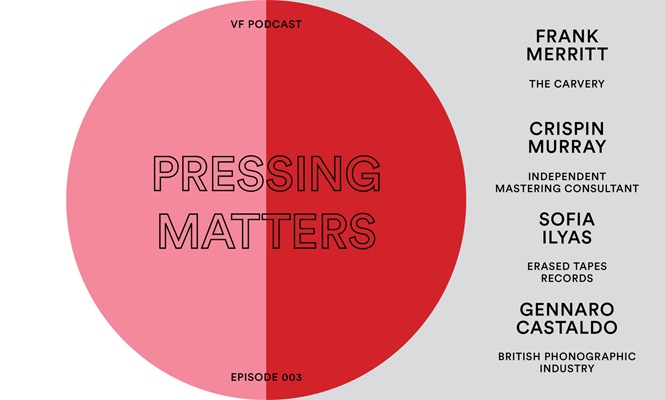Vinyl records are about to break last years selling numbers. Forecasts tending to 2 million sold copies in 2015. The Vinyl Factory has released a new podcast for the vinyl record series. The first one has been discussing if the internet ‘has ruined the joy of record collecting’. Secondly, it was the ‘issue of reissues’. Now, the third episode discusses ‘supply and demand in the vinyl industry‘. The experts in this round are Frank Merritt (The Carvery), Crispin Murray, Sofia Ilyas (Erased Tapes Records) and Gennaro Castaldo (BPI).
The discussion is split into three sections. Firstly it is going to be discussed how the manufacturing process of vinyl works. What problems can occur at this stage of production?
Secondly, the role of the record label as a transmitter between fans and factories is going to be illuminated. As well as the impact Record Store Day and Major Labels are having on the way records are released.
Lastly, demand is highlighted. Who are the actual buyers and can the growth be sustained?
Part one: the manufacturing process of the vinyl record
Crispin Murray starts off by explaining that there are only two companies (US/Japan) in the world which do the lacquer. This is needed to carry on in the pressing process.
It can be hard to get all the products needed to make a vinyl
There have been problems with this. For example, when the tsunami happened in Japan. Also, he explains in short how the manufacturing process of a record is happening.
After the lacquer is created, it goes on to the pressing plant where the plating department is carrying out a galvanic process to produce metal work from which the stampers are made and that then goes into the pressing of the final vinyl record.
Crispin Murry
The round then continues with an interesting fact. It used to take 12 days to make a vinyl, now it’s 12 weeks. It seems that very often, the problem lies within the galvanic department. Trying to produce the metalwork. It is very time-consuming to ensure a perfect outcome without pre-echos and so on.
We all ended up in a position where we had to help each other. – Frank Merrit
The vinyl had a low point in 2004
Gennaro Castaldo from the BPI stated, that after a low point in 2004, the vinyl record kind of picked up again. Indie bands such as Arctic Monkeys, White Stripes and The Strokes and the whole kind of culture around them helped a lot.
After that, a more gradual increase has been seen. It now has become far more exponential in its growth. Last year and the year before, an increase of nearly 100 % has been noted.
Record Store Day helped the vinyl
Record Store Day certainly played its part in that. Now the vinyl industry is at a moment where the capacity is nearly limiting the growth. Rather than the lack of interest.
The question has been raised as to why nobody is investing in new pressing plants. The demands are completely overdriving the manufacturing capacity. Is it too expensive to build new pressing plants? Is it a technology problem?
Where are new pressing plants?
Crispin Murray answers that: “Well there are people updating the existing presses with new parts like in the Czech Republic. But clearly, people have been a bit scared to invest.
Because of the problem of not being able to look ahead and to say how long this whole loop is going to get on.
Investors are scared how long this vinyl loop will last
But there is still some capacity reachable from the old existing presses locked away in storage. They are mainly owned to the major pressing plants, and they are not going to sell those out to not set up any rivals.
They also have more galvanic equipment from the days when pressing plants were shutting down.
Sometimes people don’t even have the time to assemble new equipment
But at the moment, they say that they are too busy to actually put this equipment back on track due to the high demand and workflow”.
Sofia Ilyas adds that: “Even if you want to do something on the equipment, it’s already so good in its performance that it only would bring seconds of the production timeline but not major adjustments”.
Vinyl production is already good at performance
New technologies like laser cutting or 3D printing don’t seem to be an option due to the complexity of the groove with all its different depths.
Actually, another problem is obtaining flat aluminium. In the ’50s, ’60s, and ’70s it was easy to get large pieces of flat aluminium. It was used for the first computers and hard drives, for example. But now flat aluminium is no longer a by-product of another industry.
Part two: What has changed for labels?
Sofia Ilyas goes first: “You have to schedule more time because everything up from January leads to Record Store Day. So you have no time for your pressing.
Also, more people do complain about bad pressings. Everything got so much more viral today”.
Teach more fans about vinyl
She urges to educate the fans more about vinyl. Explain to them how to use vinyl and what players they need and so on.
Fans do have to understand more about how vinyl records are produced.
Sofia Ilyas
It also has been discussed which impact Record Store Day is having on the limited niche of the vinyl industry. Sofia Ilyas said that it’s a strange paradox. An indie label wants to release a major album of the year and is then being told that the main competition is Record Store Day.
Record labels get frustrated with RSD
Which surely leads to some frustration and bewilderment. Frank Merrit then calls for a discussion platform about RSD. To what extent is it still sustainable or if the problems that occur with it are bigger than the benefits.
Part three: demand, buyers and sustainable growth of the vinyl record.
Gennaro Castaldo added that streaming has brought a new dynamic into the music market and especially music consumption. The physical sales were going down in demand. Since streaming became popular, a slowing of the decline can be recognised.
Streaming brings a new dynamic into the mix
He continued explaining that with streaming people can discover new music, like over curated playlists. Once they have fallen in love with something, they tend to turn to vinyl in order to have a tangible product.
A lot of vinyl buyers actually don’t have a player
A lot of people buy vinyl records without actually having a player. They do so to have, in comparison to the digital file, something to hold or even to get signed on a concert.
Gennaro Castaldo also stated that vinyl records are still only responsible for 3 % of the market (first-hand-market) even though the coverage of the media is huge.
Emotional attachment is important
As long as there is an emotional attachment to the vinyl record, the group can’t see a big problem in the future. They agree that talking about a peak of the vinyl record could be like a self-fulfilling prophecy and is therefore irresponsible.
New investment in the vinyl niche market has been encouraged. Let it be through investment into new equipment or even in whole new plants.
I loved hearing this very informative and fascinating podcast. It becomes clear that there is so much more to the resurgence of vinyl records than I assumed in the first place.
Maybe one of the main factors of the vinyl resurgence that has been underestimated is the process of manufacturing a vinyl record. It is already at such a high technical level that it completely surprises people today.
The technical level of vinyl is so good, it surprises modern tech users
We often believe new technology is superior, while disregarding the value of past technology.
Potentially, the vinyl record is relevant again, especially in an age of digital consumption, because it is already at such a high standard that it is connecting with us nowadays in ways that we can respond to it.

